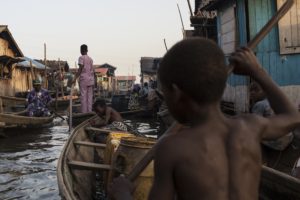
By Christopher Cottrell / Photo Credits: UNICEF
In the canals of Lagos, Nigeria, children of the Makoko fishing community begin their days early. The days are long as they ply polluted waters where raw sewage floats untreated. From these waters they subsist on the fish. It is the source of their drinking water too.
What’s worse: it’s not just the water threatening these children. They’re also suffering from the air in these canals.
According to UNICEF’s recent report one in seven of the world’s children, about 300 million in total, live in areas where the air is toxic. This is six times more dangerous than even the most basic international safety guidelines stipulate by the World Health Organization.
These findings were spotlighted last week as part of the Clear Air for the Children program was noted at a UNICEF conference in Marrakesh, Morocco.
UNICEF Executive Director Anthony Lake states, “Air pollution is a major contributing factor in the deaths of around 600,000 children under five every year – and it threatens the lives and futures of millions more every day.”
Mr. Lake further noted, “Pollutants don’t only harm children’s developing lungs – they can actually cross the blood-brain barrier and permanently damage their developing brains – and, thus, their futures. No society can afford to ignore air pollution.”
Advanced satellite images attest that roughly 2 billion children live in areas effected by outdoor air pollution. These pollutants come from cars, planes, factories, and, “heavy use of fossil fuels, dust and burning of waste,” according to UNICEF.
The report further notes that, “South Asia has the largest number of children living in these areas, at 620 million, with Africa following at 520 million children. The East Asia and Pacific region has 450 million children living in areas that exceed guideline limits.”
It further explains that, “Children are more susceptible than adults to both indoor and outdoor air pollution as their lungs, brains and immune systems are still developing and their respiratory tracts are more permeable. Young children also breathe faster than adults, and take in more air relative to their body weight. The most disadvantaged, who already tend to have poorer health and inadequate access to health services, are the most vulnerable to the illnesses caused by polluted air.”
Based on this report, UNICEF is advocating world leaders to take four urgent steps. These involve governments cutting back on the use of fossil fuels and investing in renewable energy. It insists that more be done for children’s access to overall healthcare—namely immunization campaigns and pneumonia reduction campaigns. In many areas with high levels of air pollution, pneumonia is the leading killer of children under five. The campaign also calls for stronger industrial zoning laws to keep schools and playgrounds away from centers of heavy production or waste management. This includes reducing cooker and waster burning emissions.
Lastly, UNICEF is calling for strong air pollution monitoring to alert communities of threats.
Mr. Lake added, “We protect our children when we protect the quality of our air. Both are central to our future.”
 Peace Post Asia Healthier News For The World
Peace Post Asia Healthier News For The World



